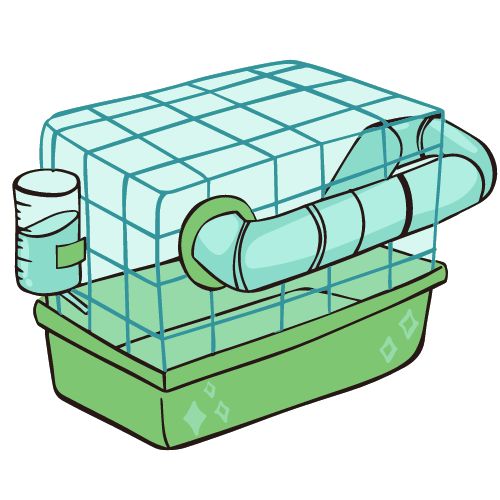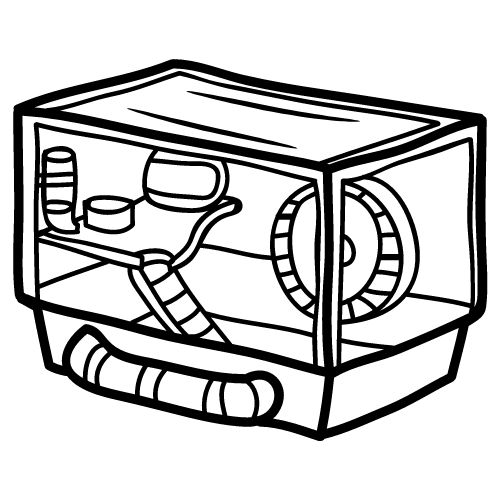A hamster cage is possibly the one item you can’t go without when owning a hamster. And if you’re new to hamster ownership, then you may not have a cage handy, hence your question about how much it costs.
A hamster cage can cost anywhere between $15 and $200 depending on the type of cage, size, features, and more. A basic, small wire cage will likely be the cheapest option, while multi-level cages with built-in tubes, tunnels, wheels, and more can run all the way up to $200 to $300.
But there’s more to know than just the price range of a hamster cage. That’s why in the following article we’re going to cover the different types of hamster cages, the cheapest options, most expensive, and ultimately what is best for your furry friend.
So feel free to click any of the links in the table of contents below or keep reading right into the first section.
First, we’re going to cover the different types of hamster cages.
What are the different types of hamster cages?
Hamster cages come in all different styles, build materials, sizes, and more. Anything you can think of when it comes to a hamster cage is probably available somewhere out there at Walmart, PetCo, or even custom sites, such as Etsy.
But generally, hamster cages are divided into two different types: wire cages and plastic cages and each have their pros and cons.
Wire hamster cages

Wire cages are generally the cheaper option, since they are just a simple enclosure made with cheaper materials with less flexibility and customization options. You can purchase a wire hamster cage starting around $15. Wire cages provide an open air space that provides sufficient air flow and they can often be multi-level, which is great for hamsters that love climbing. It’s also easier to attach some items, like wheels and water bottles directly to the cage.
But wire cages also have their limitations. They generally require more cleaning and maintenance than plastic cages and your hamster may be prone to chewing on the wire bars, so you have to be on the lookout for sharp edges and escape attempts.
Finally, wire cages also don’t have much in terms of customization with tubes and tunnels, which often require built-in connectors to the main cage. That means expanding your cage with tubes and tunnels may not be possible with a wire cage.
Plastic Hamster Cages

The second option for a hamster cage is to go the plastic route. These plastic hamster cages are typically a bit smaller, but can easily be expanded with tubes and tunnels and allow for more customization than a standard wire cage. You can expect to start paying around $30 for a basic plastic cage, but that cost increases as you add more customization to their cage.
Plastic cages often have fewer openings, which allows for a few things. First, hamsters will have a harder time chewing through the walls, ultimately reducing the possibility of injury and escape attempts. Second, fewer openings mean fewer messes, which makes regular maintenance a little bit easier.
However, every few weeks you should take apart your cage with all the tubes and tunnels and do a deep clean, which is often more tedious and difficult than just washing down a wire cage.
Finally, plastic cages are often smaller before you start expanding, so if you aren’t planning to expand with tubes, tunnels, or even additional plastic cages, you may want to go with a larger, wire cage for larger breeds of hamsters.
What is the cheapest type of hamster cage?
Wire cages are the cheapest type of hamster cage, generally starting around $15, because they are made with fairly cheap materials and can be made at scale with few customization features. However, they come in a wide variety of sizes so if looking for a big cage right off the bat is what you’re looking for, then a wire cage may be the right choice.
While wire cages are the cheapest, they have lots of benefits:
- Low cost
- Easy to clean
- Plenty of ventilation
- Gives your hamster places to climb
- Comes in a wide variety of sizes
- Comes in wide variety of colors and designs
However, there are also lots of downsides when it comes to wire cages:
- Difficult to customize with tubes and tunnels
- Not as much privacy as plastic cages
- Hamsters can chew the bars, creating sharp edges and choking hazards
- Other animals can easily see into the cage and even poke their paws through
Overall, whether a wire cage is right for you and your furry friend depends on those factors above. If cost is the most important factor (and it never should be) then a wire cage may be a good choice. But you should always think of your hamster’s comfort and lifestyle first.
If you want to customize your cage, love the idea of tubes and tunnels, and are worried about your hamster chewing the cage bars, then a plastic cage may be the right choice instead.
What is the most expensive type of hamster cage?
If you’re looking to setup your furry friend in the lap of luxury, then multi-level, elaborate cage is the right option. However, these types of cages are the most expensive and normally made from high-end materials, not like the cheaper wire or plastic cages. But you’ll pay for it.

These cages generally start at $100 and only go up from there, but these multi-level, custom hamster cages contain all the bells and whistles. They’re often made from glass or a combination of glass and heavy metal for sturdiness and reliability.
They also come with a wide range of accessories, such as built-in wheels, multi-level stories, tubes, tunnels, slides, and more. The benefits are are that they provide your hamster with plenty of options for activity and exercise in their cage and you don’t have to pay for them separately from the cage, which you should factor into the higher cost.
These types of cages aren’t the typical eyesore of a hamster cage either. They’re designed to fit into the modern design of any home. So much so that guests may not even notice they’re looking at a hamster cage when they first encounter your hamster’s home. And these cages are generally larger, giving your hamster the room they need to live comfortably.
So in conclusion, if you’re looking for the best for you hamster, a larger, multi-level custom hamster cage may be the right choice for you if everything listed above sounds ideal.
What is the best hamster cage?
The best hamster cage is the one that meets and exceeds all of your hamster’s needs for a happy and comfortable life. When you take price out of the equation, you want your hamster cage to be a good place for your hamster to spend nearly their entire life.
The factors that make a good hamster cage generally include size, quality of materials, options for activity, ventilation, ability to easily clean, and more.
| Factors That Make a Good Hamster Cage | Description |
|---|---|
| Size | You want your hamster to have enough space to live comfortably. |
| Quality of Materials | Hamsters will chew everything, so you want the materials to be high-quality so they won’t get sick or choke on low-quality materials. |
| Options for Activity | Hamsters need lots of options for activity, so cages that have built-in wheels, shelves, tubes, and tunnels makes for good cages. |
| Ventiliation | Air flow is very important for your hamsters because if there isn’t sufficient air flow they can suffocate and even die if it’s not addressed. |
| Ability to Easily Clean | While hamsters won’t be cleaning their own cage, if it’s not easy to clean, you may not either. So you want a cage that is easy to clean so you don’t mind cleaning it so often. |
If you can find a wire, plastic, or custom-built cage that meets these needs, then it’s a good cage. But just be aware that the less you spend, the harder it will be to check all of those boxes.
Generally, we would recommend spending at least $50 on your hamster’s cage to ensure it is large enough, made of high-quality materials, and has plenty of options to keep your hamster busy and active in their cage.
The cage is the biggest expense when you acquire a hamster and since it’s their home, you shouldn’t skimp on it. Just imagine if you had to live in your bedroom for your entire life. You would hope someone took the time to make it as good as they could.
Hamster cages will also last a long time, so consider it a solid investment, especially if you may continue to get and own hamsters in the future.
Additional Reading
If you’re interested in seeing what type of hamster cages are out there, check out the following links:
- Hamster Cages – PetCo
- Hamster Cages and Enclosures – Chewy.com
- Hamster Cages – Amazon.com
Conclusion
A hamster cage is the single most important item you’ll buy for your furry friend because it’s their home that they will spend the majority of their life inside. So you want to make sure you’re getting the right cage.
But since this article was about the cost of a hamster cage, you can expect to pay anywhere between $15 and $200 for a hamster cage depending on the factors that make it a good option.
And we generally don’t recommend spending less than $50 on your cage, while considering what makes a cage a good option. Those factors are typically size, ventilation, options for activity, quality of materials, and the ability to easily clean the cage.